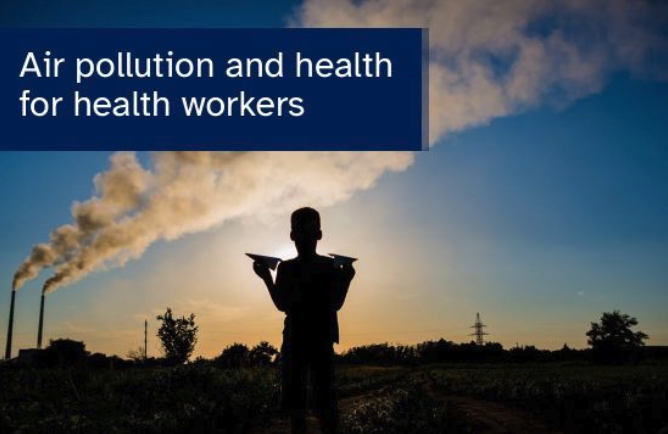
TOOL
Air pollution and health: an introduction for health workers
Explore health-relevant side events, news and resources from the 2025 UN Climate Conference.
Health at COP30 >Many indoor and outdoor workers face health hazards that are exacerbated by climate change. Climate conditions can amplify existing workplace health and safety issues, and workers may be exposed to hazards that the general public can avoid. For some, including migrant workers and day laborers, inadequate housing or other social and economic constraints may mean they face climate-related hazards both at home and at work, increasing their vulnerability.
Examples of climate-related occupational hazards include workplace exposure to high temperatures, air pollution, extreme weather and natural disasters, and biological hazards. These hazards often do not occur in isolation but in compounding and cascading ways amplifying health risks of workers.
Climate change is affecting the frequency, intensity, and duration of heatwaves, and occupational heat stress can impact the productivity, safety and health of both outdoor and indoor workers who don’t have access to appropriate cooling.
In 2021, heat exposure led to the loss of 470 billion potential labour hours, a 37% increase from 1990-1999.1 1Romanello, Marina, et al. The 2022 report of the Lancet Countdown on health and climate change: health at the mercy of fossil fuels. The Lancet (2022).By 2030, the equivalent of more than 2% of total working hours worldwide is projected to be lost every year, either because it is too hot to work or because workers have to work at a slower pace – a productivity loss equivalent to 80 million full-time jobs. In Southern Asia and Western Africa the resulting productivity loss may even reach 5%.2 2ILO: Working on a warmer planet: The impact of heat stress on labour productivity and decent work
Workers who are exposed to extreme heat, prolonged work in hot environments (indoor and outdoor), or are engaged in strenuous physical activity may be at risk for heat stress. Heat stress can lead to heat illness and death. Occupational exposure to heat has also been associated with increased risk of traumatic injury.
Numerous factors, including worksite location and weather conditions, may affect occupational exposure to air pollution, which has been linked with both acute and chronic health effects including heart disease, respiratory diseases, and allergic disorders, and can cause decreased productivity in the workplace.
Extreme weather events such as floods, landslides, storms, lightning, droughts, and wildfires are associated with occupational deaths, injuries, diseases, and mental stress. Workers involved in rescue, cleanup and restoration are exposed to hazardous conditions both during and after extreme weather events.
Learn more about health and storms, floods, droughts, wildfires and geological hazards >
Climate conditions such as temperature and rainfall affect the prevalence and distribution of vectors, pathogens, hosts and allergens. People who work closely with the natural environment, including soil, water, animals and infrastructure, may face an increased risk of exposure to pathogenic microorganisms and infectious diseases due to climate change.
Associated health impacts include food-borne and water-borne diseases; asthma and allergies triggered by pollen; mold-related asthma; skin and lung irritation from poisonous plants; and vector-borne disease such as Lyme disease, dengue, chikungunya and Zika virus disease.
The most vulnerable occupational groups include outdoor workers, emergency responders, post-disaster remediation and construction workers, and health care workers. In addition to the direct health impacts associated with biological hazards, exposure to pesticides has been associated with a variety of adverse occupational health outcomes.
Learn more about biological hazards and health >
Exposure to environmental chemicals is expected to significantly increase as a result of climate change. Polycyclic aromatic hydrocarbons (PAHs), which are formed during the burning of carbon-containing materials such as petroleum-based fuels and biomass materials that include crops and forests, are on the rise, in part due to global warming. More than 15 of the 100 chemicals classified as PAHs are known to be mutagenic and carcinogenic, and increased exposure to them have been linked to cancer and ischemic heart disease.
Many workers around the world, particularly those working in trades or industries using or producing coal or coal products, are at the highest risk for PAH exposure. Those who work in close proximity to these types of combustion sources also include traffic police, tunnel construction workers, garage workers, taxi drivers and wildland firefighters 3 3Hazard Zone: The Impact of Climate Change on Occupational Health
Climate change is expected to exacerbate conflict. Research shows that deviations from normal rainfall and moderate temperatures systematically increased violence and conflict across major regions of the world over time, and multiple studies have found a compelling link between heat and crime. This increase in conflict will increase the risk of injury and mortality for an array of occupations, including law enforcement, security personnel, armed forces, disaster response personnel, emergency medics, firefighters, and homeland security and border security personnel.4 4Hazard Zone: The Impact of Climate Change on Occupational Health
Research
EN
Research
EN
Research
EN